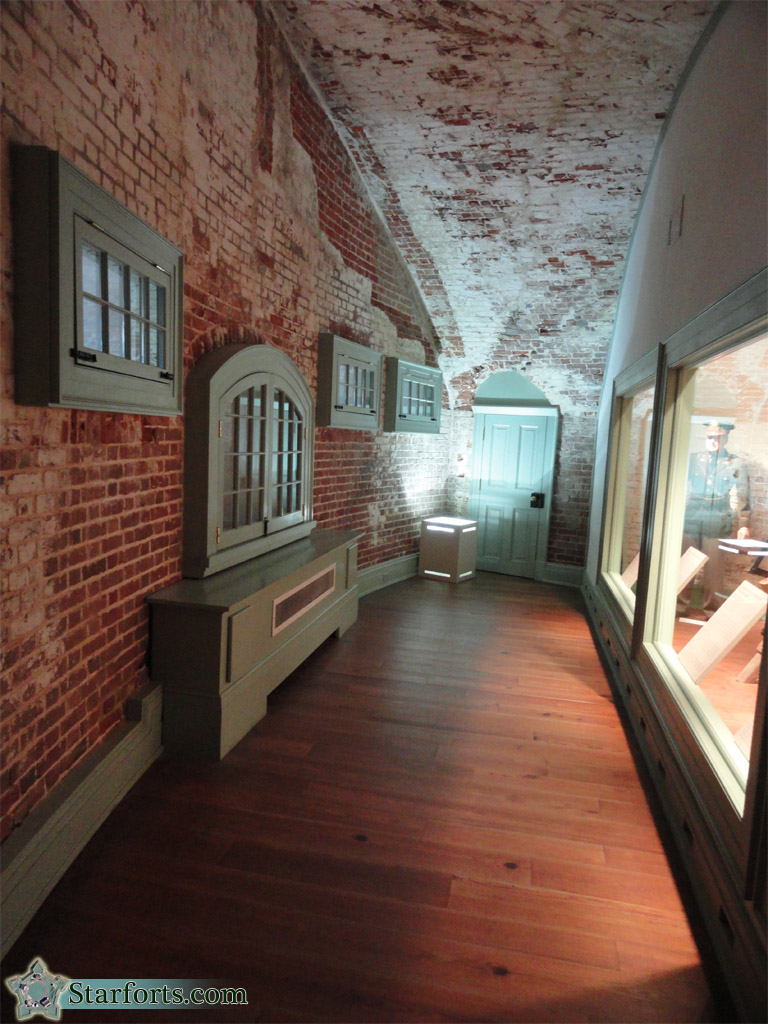

Behind the restored gunpowder magazine is a small display of the uniforms worn at Fort Macon, 1834-1944. More interesting to me were the weird contraptions tacked to the casemate wall to the left.
As I believe I've mentioned at least a thousand times by now, life in a casemate would have been unpleasant for anybody. Soldiers of all eras were expected to endure hardship when necessary, but by the 20th century they weren't expected to suffer quite as much as had been the case in previous centuries. Plus officers were never expected to be uncomfortable, with the possible exception of when they were being actively fired upon.
One of the main issues that had to be addressed when living in a casemate built in the 1830's was that there was no way to effectively seal off the opening built into the outside wall of each casemate...short of bricking it in, but the whole point of that opening was that it be open and available to be fired through at a moment's notice. Various solutions were tried, including creaky iron shutter systems that I've seen at a number of American starforts
By the time Fort Macon was garrisoned during the Second World War, however, the assumption was that nobody would need to be firing anything directly from the casemates: Ten 155mm mobile field guns were arranged in batteries around Fort Macon, with an additional two naval guns mounted on fixed pedestals, and if those couldn't deal with an attacking Japanese amphibious force, various automatic weapons would doubtless open up closer in...the thought of defending the individual casemates wasn't part of anybody's battleplan. And the soldiers stationed at the fort were fricking freezing. Thus, these window units were screwed into the casemate's bricks, which I'm sure didn't attenuate the problem completely, but had to be better than 100-year-old creaky iron shutters.
As I believe I've mentioned at least a thousand times by now, life in a casemate would have been unpleasant for anybody. Soldiers of all eras were expected to endure hardship when necessary, but by the 20th century they weren't expected to suffer quite as much as had been the case in previous centuries. Plus officers were never expected to be uncomfortable, with the possible exception of when they were being actively fired upon.
One of the main issues that had to be addressed when living in a casemate built in the 1830's was that there was no way to effectively seal off the opening built into the outside wall of each casemate...short of bricking it in, but the whole point of that opening was that it be open and available to be fired through at a moment's notice. Various solutions were tried, including creaky iron shutter systems that I've seen at a number of American starforts
By the time Fort Macon was garrisoned during the Second World War, however, the assumption was that nobody would need to be firing anything directly from the casemates: Ten 155mm mobile field guns were arranged in batteries around Fort Macon, with an additional two naval guns mounted on fixed pedestals, and if those couldn't deal with an attacking Japanese amphibious force, various automatic weapons would doubtless open up closer in...the thought of defending the individual casemates wasn't part of anybody's battleplan. And the soldiers stationed at the fort were fricking freezing. Thus, these window units were screwed into the casemate's bricks, which I'm sure didn't attenuate the problem completely, but had to be better than 100-year-old creaky iron shutters.
 |
 |
 |